

Geodesy. The science of the geometric shape, orientation in space, and gravitational field of Earth Definition[edit] The word "geodesy" comes from the Ancient Greek word γεωδαισία geodaisia (literally, "division of Earth").
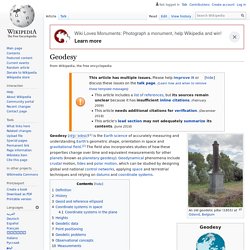
It is primarily concerned with positioning within the temporally varying gravity field. Geodesy in the German-speaking world is divided into "higher geodesy" ("Erdmessung" or "höhere Geodäsie"), which is concerned with measuring Earth on the global scale, and "practical geodesy" or "engineering geodesy" ("Ingenieurgeodäsie"), which is concerned with measuring specific parts or regions of Earth, and which includes surveying.
Such geodetic operations are also applied to other astronomical bodies in the solar system. Gravitoelectromagnetism. Gravitoelectromagnetism, abbreviated GEM, refers to a set of formal analogies between the equations for electromagnetism and relativistic gravitation; specifically: between Maxwell's field equations and an approximation, valid under certain conditions, to the Einstein field equations for general relativity.

Gravitomagnetism is a widely used term referring specifically to the kinetic effects of gravity, in analogy to the magnetic effects of moving electric charge. The most common version of GEM is valid only far from isolated sources, and for slowly moving test particles. The analogy and equations differing only by some small factors were first published in 1893, before general relativity, by Oliver Heaviside as a separate theory expanding Newton's law.[1] Background[edit] ...or equivalently currentI, same field profile, and field generation due to rotation. Henri Poincaré. French mathematician, physicist, engineer, and philosopher of science Jules Henri Poincaré (,[4] ;[5][6][7] French: [ɑ̃ʁi pwɛ̃kaʁe] ( listen);[8][9] 29 April 1854 – 17 July 1912) was a French mathematician, theoretical physicist, engineer, and philosopher of science.

Roger Penrose. Sir Roger Penrose OM FRS (born 8 August 1931) is an English mathematical physicist, mathematician and philosopher of science.
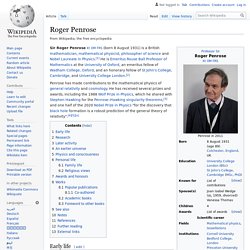
He is Emeritus Rouse Ball Professor of Mathematics at the University of Oxford and an emeritus fellow of Wadham College, Oxford. Penrose has made contributions to the mathematical physics of general relativity and cosmology. He has received several prizes and awards, including the 1988 Wolf Prize for physics, which he shared with Stephen Hawking for the Penrose–Hawking singularity theorems. Early life and academia[edit] As reviewer Manjit Kumar puts it: As a student in 1954, Penrose was attending a conference in Amsterdam when by chance he came across an exhibition of Escher's work. Following up his "weak cosmic censorship hypothesis", Penrose went on, in 1979, to formulate a stronger version called the "strong censorship hypothesis".
Hendrik Lorentz. Dutch physicist Hendrik Antoon Lorentz (/ˈlɒrənts/; 18 July 1853 – 4 February 1928) was a Dutch physicist who shared the 1902 Nobel Prize in Physics with Pieter Zeeman for the discovery and theoretical explanation of the Zeeman effect.
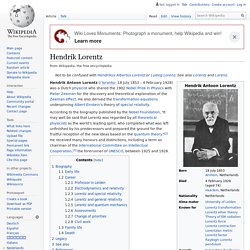
He also derived the transformation equations underpinning Albert Einstein's theory of special relativity. Albert Einstein. German-born scientist who developed the theory of relativity Albert Einstein ( EYEN-styne;[4] German: [ˈalbɛʁt ˈʔaɪnʃtaɪn] ( listen); 14 March 1879 – 18 April 1955) was a German-born theoretical physicist[5] who developed the theory of relativity, one of the two pillars of modern physics (alongside quantum mechanics).[3][6] His work is also known for its influence on the philosophy of science.[7][8] He is best known to the general public for his mass–energy equivalence formula E = mc2, which has been dubbed "the world's most famous equation".[9] He received the 1921 Nobel Prize in Physics "for his services to theoretical physics, and especially for his discovery of the law of the photoelectric effect",[10] a pivotal step in the development of quantum theory.
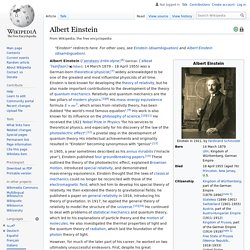
The son of a salesman who later operated an electrochemical factory, Einstein was born in the German Empire, but moved to Switzerland in 1895, forsaking his German citizenship the following year. Life and career Marriages and children. Minkowski space. Hermann Minkowski (1864–1909) found that the theory of special relativity, introduced by his former student Albert Einstein, could be best understood as a four-dimensional space, since known as the Minkowski spacetime.

Minkowski space is closely associated with Einstein's theory of special relativity and is the most common mathematical structure on which special relativity is formulated. While the individual components in Euclidean space and time may differ due to length contraction and time dilation, in Minkowski spacetime, all frames of reference will agree on the total distance in spacetime between events. [nb 1] Because it treats time differently than it treats the 3 spatial dimensions, Minkowski space differs from four-dimensional Euclidean space. Wick rotation. In physics, Wick rotation, named after Gian Carlo Wick, is a method of finding a solution to a mathematical problem in Minkowski space from a solution to a related problem in Euclidean space by means of a transformation that substitutes an imaginary-number variable for a real-number variable.
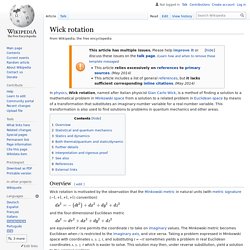
This transformation is also used to find solutions to problems in quantum mechanics and other areas. Gravity in einsteinian space - Google 検索. Einstein's genius changed science's perception of gravity. Albert Einstein opened humankind’s eyes to the universe.

Before Einstein, space seemed featureless and changeless, as Isaac Newton had defined it two centuries earlier. And time, Newton declared, flowed at its own pace, oblivious to the clocks that measured it. But Einstein looked at space and time and saw a single dynamic stage — spacetime — on which matter and energy strutted, generating sound and fury, signifying gravity. Euclidean quantum gravity. In theoretical physics, Euclidean quantum gravity is a version of quantum gravity.
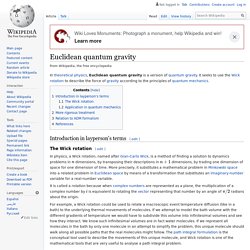
It seeks to use the Wick rotation to describe the force of gravity according to the principles of quantum mechanics. Introduction in layperson's terms[edit] Newton's law of universal gravitation. The equation for universal gravitation thus takes the form: James Clerk Maxwell. James Clerk Maxwell FRS FRSE (13 June 1831 – 5 November 1879) was a Scottish[2][3] scientist in the field of mathematical physics.[4] His most notable achievement was to formulate the classical theory of electromagnetic radiation, bringing together for the first time electricity, magnetism, and light as different manifestations of the same phenomenon. Maxwell's equations for electromagnetism have been called the "second great unification in physics" [5] after the first one realised by Isaac Newton. With the publication of "A Dynamical Theory of the Electromagnetic Field" in 1865, Maxwell demonstrated that electric and magnetic fields travel through space as waves moving at the speed of light.[6] He proposed that light is an undulation in the same medium that is the cause of electric and magnetic phenomena.[7] The unification of light and electrical phenomena led his prediction of the existence of radio waves.
Contents Life Early life, 1831–1839 Education, 1839–1847 ... Personal life Legacy. Coulomb's law. Fundamental physical law of electromagnetism. D 91, 124053 (2015) - General-relativistic rotation laws in rotating fluid bodies. Theoretical physics. Hans Thirring. Hans Thirring (March 23, 1888 – March 22, 1976) was an Austrian theoretical physicist, professor, and father of the physicist Walter Thirring.
He won the Haitinger Prize of the Austrian Academy of Sciences in 1920.[1] Together with the mathematician Josef Lense, he is known for the prediction of the Lense–Thirring frame dragging effect of general relativity in 1918.[2][3][4] He received a deferment during World War I because he had broken one of his feet while skiing. He was a leading pacifist before the Anschluss and after World War II. But he could not save his older son, who was declared missing in action during the final two months of World War II. References[edit] ^ Dazinger, Walter (27 January 2014). External links[edit] Frame-dragging. In 2015, new general-relativistic extensions of Newtonian rotation laws were formulated to describe geometric dragging of frames which incorporates a newly discovered antidragging effect.[4] Effects. Lense–Thirring precession. In general relativity, Lense–Thirring precession or the Lense–Thirring effect (named after Josef Lense and Hans Thirring) is a relativistic correction to the precession of a gyroscope near a large rotating mass such as the Earth.
It is a gravitomagnetic frame-dragging effect. Gravitoelectromagnetism. Statistical Models by David A. Freedman. David A. Freedman. Biography and awards[edit] Cosmic microwave background. Electromagnetic radiation as a remnant from an early stage of the universe in Big Bang cosmology. Robert Woodrow Wilson. Robert Woodrow Wilson (born January 10, 1936) is an American astronomer who, along with Arno Allan Penzias, discovered cosmic microwave background radiation (CMB) in 1964. Howardson and walker cosmological universe - Recherche Google.